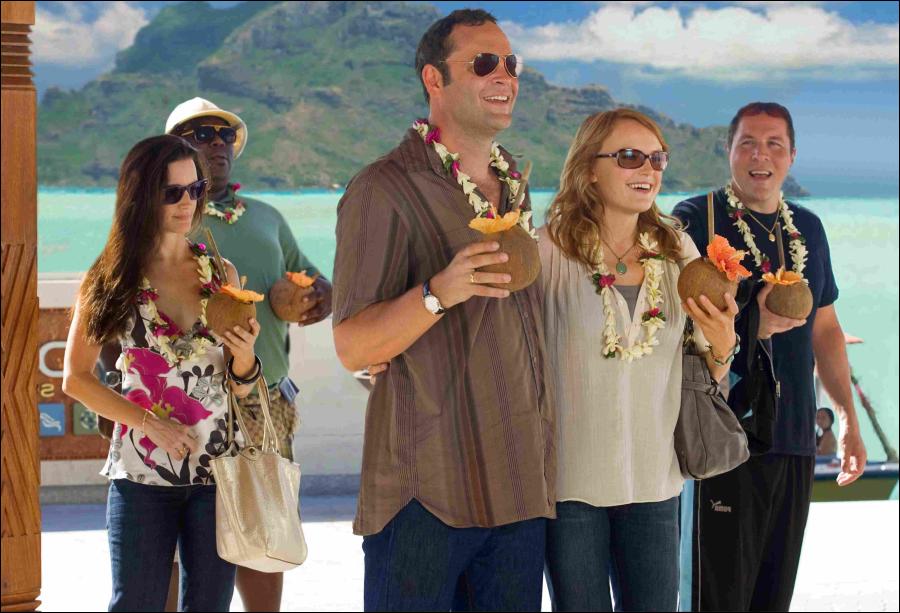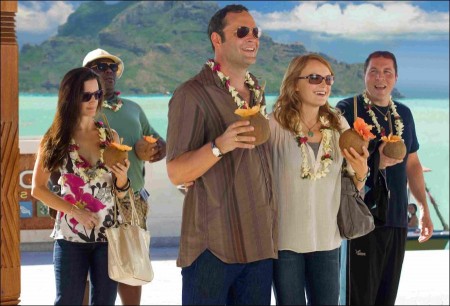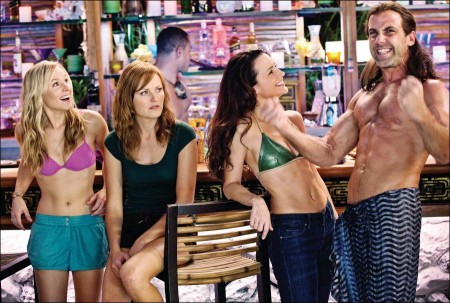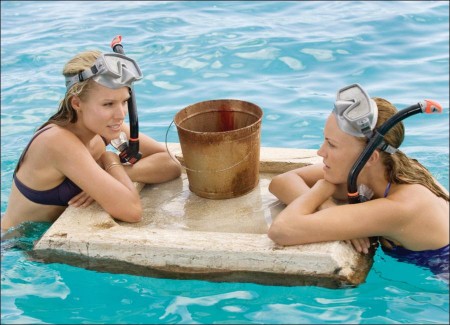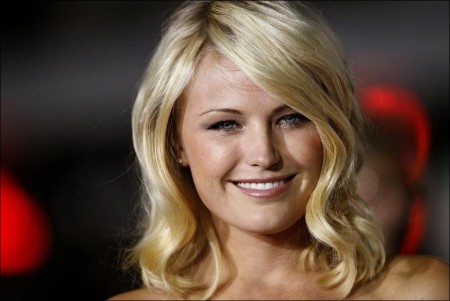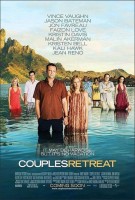About the Production
In 1996, Vince Vaughn and Jon Favreau came onto Hollywood’s radar with the comedy Swingers. The film, written by Favreau, depicted the lives of two unemployed actors trying to score with the ladies and make it big in L.A. It became an instant classic, launching both men’s careers… and serving as the unlikely beginning for Couples Retreat. In 2007, the much-loved and often-quoted movie won the Guy Movie Hall of Fame Award at Spike TV’s Guys Choice Awards. Following the taping of the show, Vaughn and Favreau revisited one of their film’s haunts, The Dresden Room, to celebrate. There, Vaughn pitched Favreau the concept for Couples Retreat.
“I had this idea about a group of friends who are married and having typical relationship problems, with some being more extreme than others,” says Vaughn. “One of them was the catalyst who tells the others, `I found this place that is the Mecca for all things for couples.’ He needs his friends to go because the only way he and his wife can afford it is with the less expensive group rate. The other couples think it will be a great vacation, but when they get there they realize they must participate in all of the couples therapy exercises. The fun is in seeing all of their relationships put under a microscope.
“I had wanted to take normal people with everyday problems and put them in an exceptional setting,” continues Vaughn. “The story had to be relatable so audiences would see a bit of themselves in one of the four couples…and have some laughs at the situations and obstacles they face and must work through. I also wanted the script to have hope and wish fulfillment. Even though things can be trying, it’s better to love and work on the relationship than not to have it at all.”
Favreau was open to teaming with his longtime friend. “Vince approached me with the idea of collaborating together again for the first time in many years,” he says. “And when he pitched me the idea for Couples Retreat, I thought the concept was compelling.”
Vaughn also reached out to Scott Stuber, the producing partner with whom Vaughn had collaborated on the 2006 anti-romantic comedy and blockbuster hit The Break-Up, about reteaming on this film. “Vince and I always talk about new ideas to do together. When he told me about the concept for Couples Retreat, I thought it was a great way to explore relationships
Once Favreau agreed to write the screenplay with Vaughn and fellow comedy writer Dana Fox, the collaborators begin fleshing out a story. They focused on four Midwestern couples-the seemingly perfect couple Dave & Ronnie, the overly analytical Jason & Cynthia, the ready-to-split Joey & Lucy and the recently separated Shane & his 20-year-old girlfriend Trudy-whose relationships are put to the test at the resort.
For Favreau, the premise of the film was one he could relate to; this would be his most personal film since Swingers. “I have experienced marriage and having small children. It’s something I hadn’t explored yet.”
Stuber adds: “What I loved about the script was that it explored human behavior and relationships, and there was real hope and joy to it. I knew it would also be great to make this film with a group of us who are all friends. The more you can make films with people you share common sensibilities with, the more you want to keep replicating that experience.”
Vaughn’s search for a director began and ended with Peter Billingsley, who makes his directorial debut with Couples Retreat. Billingsley had an accomplished body of work as a producer, including production partnerships with Vaughn on Made, The Break- Up and Four Christmases, and with Favreau on Made, Zathura, Iron Man and the television project Dinner for Five. His desire to direct, however, began as a young actor when he was cast to play the BB gun-loving Ralphie in the holiday classic A Christmas Story.
“When we were shooting A Christmas Story, I spent a lot of time on set with director Bob Clark,” says Billingsley. “Over the years, I have been curious about his process, and he gave me the best piece of advice when I told him I wanted to be a filmmaker. He said `Get in the edit room, because that’s where you’ll learn how to make a movie.’ So I started spending as much time in postproduction as I could. I felt if directing was something that was meant to be, the right project would materialize.”
As a partner for the past several years in Vaughn’s Wild West Picture Show Productions, Billingsley had a relationship with Vaughn that made the choice a simple one. “Vince and I have a great shorthand, which comes from being collaborators and friends for such a long time,” notes the filmmaker. “Couples Retreat is our fourth movie together. Our earlier projects helped me prepare to direct this film. I understand how Vince likes to develop story and characters, and we both knew what we wanted to achieve with this film.”
With Billingsley signed as director, the project was set up at Universal Pictures under Vaughn’s Wild West Picture Show Productions’ and Stuber’s Stuber Pictures’ production deals. Vince Vaughn, Jason Bateman, Jon Favreau and Faizon Love were attached to the project before the script was written, giving the writers the luxury of knowing the voices of the lead actors before shooting began. “Because Vince and I now have the ability to get films made, he was able to identify and secure the actors he wanted to play the male roles,” says Favreau. “This was great because when I have a voice of somebody to write for, I have a much easier time.”
When casting, the director and producers looked for not just comic actors, but performers who could also handle dramatic turns. “Three of the four couples have been married for many years, so they had to have those nuances down that are common in marriage,” says Stuber. “All of the actors had to be extremely likeable and have a natural repartee. Vince, Jon, Jason and Faizon have all been friends for a long time, but Kristin, Kristen, Malin and Kali were new to the group. The four of them hit it off right away and seemed like old friends. I know audiences will relate to each couple and root for them to overcome their problems and work it out.”
For Vaughn, Dave was a character that he felt was very relatable and to which audiences can connect. “Dave is an everyday guy who has a great life,” says Vaughn. “He’s a great father and husband, but he never takes the time to slow it down and appreciate his life. When he gets to the island, he’s forced to stop and reflect: `Do my wife and I have problems…or are the counselors here overstepping their boundaries?’”
Billingsley appreciated his friend’s take on what could easily have been a stock character. He notes: “Vince’s sense of story, character and purpose is terrific. You’re putting people in a situation and figuring out an interesting way of how that plays out. When he gets connected to a character, he finds even more elevated ways of expressing the intention than what is on the page.”
Jason Bateman takes on the role of Jason, an overly analytical husband whose PowerPoint presentation convinces his friends to go to Eden. “Jason’s character kicks off the film,” explains Vaughn. “He and his wife are having issues in their marriage and they think that by taking a trip to the ultimate couples paradise, it will enlighten them in their decision to either stay together or get divorced. Ultimately, all of the couples have their own reasons for going.”
“I received a call and heard there was a comedy with Vince Vaughn and Jon Favreau. It was set in Bora Bora, and they named my character with my real name. It just doesn’t get any better,” laughs Bateman. “They wrote the character to my sense of humor: the way I speak, my whole meter. I’ll probably have to refund a bit of my money to Universal, but I hope to make up for that with my performance.”
Favreau had double duty, both as one of the writers and as Joey, an unhappily married man on the edge of divorce. “My own personal experience is reflected mostly in Vince’s character, Dave. The others reflect extreme examples of how relationships can go wrong,” admits Favreau. “Joey is what happens when you stop working on your marriage and everything dies, but you go through the motions for 20 years.”
“I think a lot of people can relate to Joey and Lucy, whose kid is leaving for college and they are about to experience the empty-nest syndrome,” says Stuber. “It soon becomes `Are we still a couple? Are we still connected to each other?’ Jon is both an amazing writer and actor and can easily convey those emotions on screen. His familiarity with Vince and the cast helps elevate these performances.”
Separated from his wife and going through his own midlife crisis is Shane, played by Faizon Love, another collaborator of both Vaughn’s and Favreau’s. “When they asked me to do it, it felt like a school project because Jon, Vince, Peter and I have been friends for a long time,” says Love. “Shane is not in a great place and has a 20-year-old girlfriend, but she makes him feel young again and he is trying to forget about the fact that he’s getting divorced.”
“Faizon’s one of those guys that, anything he does, you’re drawn to him,” commends Vaughn. “His character is very funny, but he’s also so endearing because you feel for what he’s going through. Faizon was perfect for the role because he exudes that combination of being someone who is funny and who you root for.”
In casting the female leads of Malin Akerman, Kristen Bell, Kristin Davis and Kali Hawk in the comedy, the filmmakers found a combination of actresses that would be believable as friends and serve as a strong counterpoint to the men.
Taking on the role of Dave’s wife, Ronnie, is Swedish actress Malin Akerman, recently seen as the sultry Silk Spectre II in the action film Watchmen. Many audiences, however, know Akerman from her comic roles in The Heartbreak Kid and The Proposal. “What I liked about the story was that the four couples are so different,” explains Akerman. “I’ve been married for two years, and the story is very relatable. Relationships are tough, and it takes a lot of work. Sometimes, we take things so seriously that we forget it’s the simple little things that matter.”
About choosing her for the role, Billingsley explains: “Ronnie and Dave are the eyes of the audience. If they’re the sane people in this insane world, they have to be the most grounded. We saw Malin in The Heartbreak Kid and thought she was very funny and right for Ronnie. Malin had to do some extreme humor in that film, which required an amazing commitment. We thought if somebody can do that so elegantly and in a likeable, committed way, that’s a sign of a gifted actress.”
In casting the role of Jason’s equally analytical wife, Cynthia, the filmmakers turned to Kristen Bell, star of the 2008 hit Forgetting Sarah Marshall. “Cynthia was very important for a couple of reasons,” explains Billingsley. “There isn’t infidelity in her marriage, but she is very type A and feels there’s a path and a process to everything. If you follow that path, things will always work out. We wanted someone who was beautiful and represented an amazing wife for Jason. Kristen had those qualities. I had never met her before, but after spending an hour with her in a general meeting, we were all convinced she should play Cynthia.”
“I don’t know that I see so much of myself in Cynthia, but it is an easy stretch,” laughs Bell. “She is who I wouldn’t mind being sometimes: always on time, very schedule-oriented, determined and always on top of everything. She focuses on the problem, yet she’s solution-oriented. But you can’t always live like that, and that’s exactly why she and her husband are having problems.”
For the role of Lucy, Joey’s unfaithful other half, the filmmakers went against type in casting Sex and the City star Kristin Davis. “Lucy’s a very different role for me,” says Davis. “It was funny because when I first read the script, I thought, `Did they really want me to play Lucy?’ I kept going back to the descriptions, because I am definitely not the obvious choice. But that’s why it’s fun and exciting. Sometimes it takes other actors to see an actor differently.” The filmmakers felt it would be ridiculous to make a film about couples and not address infidelity. For the role of the married young mother with a roving eye, Billingsley and the producers felt Davis would bring a likeable energy to a potentially unsavory character.
Vaughn offers: “Kristin has been doing comedy for a long time. She’s very funny and has great timing. There’s also something naturally likeable about her. She made perfect sense, because we needed someone who the audience would root for and willingly take that journey with.”
Making her first starring turn in a feature film as Trudy, the boisterous 20- year-old girlfriend of Shane, is Kali Hawk. “Trudy does what she wants, and she is very unapologetic about it,” offers Hawk. “I have a friend who’s similar to this character; a lot of the things Trudy says in the film are similar to what my friend says in real life. I’m much more cautious, whereas Trudy, if she doesn’t like something, she’ll just blurt it out. She doesn’t really fit in with Shane and his friends, but out of everyone, she’s the only one who hasn’t lost the ability to just have fun.”
The filmmakers auditioned a number of performers for the role of Trudy and decided on Hawk. Stuber commends, “Kali had a difficult task ahead of her when she was cast as Trudy, and she easily held her own. Time after time, with just a small look or a turn of her head, she made us all laugh out loud.”
After Jason and Cynthia convince their friends to come to Eden, the other couples discover that activities such as jet skiing or lying on the pristine beach can only be enjoyed after the couples therapy and skill-building programs that begin at 6 a.m. Keeping each of the pairs in line is the resort’s withering host and endless taskmaster, Sctanley (pronounced “Stanley”), played by British comedian Peter Serafinowicz. Sctanley brings a very conservative nature and stiff upper lip and proves a fun antagonist for Dave.
Eden Resort staff is yoga instructor Salvadore, played by the Puerto Rican-born Carlos Ponce. With his chiseled physique and long flowing locks, Salvadore’s “hands-on” teaching method pushes the personal boundaries of the couples he teaches.
All of the teachings at Eden are based on the philosophies of world-renowned couples guru Monsieur Marcel, played by Jean Reno. “If there is one message Marcel would like to share with the world, it’s to be naked in front of the people you like,” laughs Reno. “Be naked inside your mind, not only physically. Don’t hide and don’t lie. Even if it hurts, it is always better to say the truth to people that you love.
Cast in the roles of Dave and Ronnie’s sons, Changeling’s Gattlin Griffith and newcomer Colin Baiocchi give memorable performances as eight-year-old Robert and five-year-old Kevin. Rounding out the supporting cast of Couples Retreat is Why Did I Get Married?’s Tasha Smith as Jennifer; Star Wars series’ Temuera Morrison as Marcel’s second-in-command, Briggs; newcomer Jonna Walsh as Lucy and Joey’s college-bound daughter, Lacey; and The Break-Up’s John Michael Higgins and The Hangover’s Ken Jeong as two of Eden Resort’s unorthodox therapists. With the casting process complete, the filmmakers began their search for the perfect location for Eden Resort, the world’s most stunning retreat for couples.
There were several tropical isles considered for the setting of Couples Retreat, including locations in Hawaii, the Caribbean, Mexico, the Bahamas and Bali. “I asked our production designer, Shepherd Frankel, `If we could pick anywhere in the world to shoot this film, where would that be?’ recalls Billingsley. “So we started looking at every tropical place on the planet.” Once the filmmakers saw the aqua-blue water that surrounds the white-sand beaches of the remote island of Bora Bora, they knew they had found the ideal backdrop for Eden Resort.
Couples Retreat is the first film to shoot in this part of the South Pacific since Jan Troell shot the epic adventure Hurricane in 1979. The filmmakers searched more than a dozen resorts on this French Polynesian island, focusing on hotels that had overwater bungalows and exuded relaxation. “The key was to find a place that would allow us to take over an entire resort,” explains Billingsley.
After scouting the island, the filmmakers struck a deal with the St. Regis Bora Bora Resort, which would be transformed into their Eden. The resort is a five-star hotel on Bora Bora located on Motu Piti Aau (“Two Hearts” in Tahitian). The 13,000-square-foot royal estate is surrounded by white sands and an idyllic lagoon extends over three separate pavilions and has the towering Mount Otemanu as its backdrop.
“The St. Regis is spectacular and is its own self-contained island with no roads and no cars,” says the director. “The only way to get there is by boat, and the over-water bungalows are amazing. They have more than 1,800 square feet, which gave us plenty of room to shoot inside. They also have a beautiful lagoon with the mountain of Bora Bora in the background; that worked perfectly for the yoga dock we wanted to build. They were willing to shut the entire resort down, which allowed us full use of their property.”
While the island provided the production with breathtaking visuals, it also posed its share of challenges. “There was a massive logistical effort by our team in preproduction,” says Billingsley. “Victoria Vaughn, Guy Riedel and [unit production manager] UDI NEDIVI sat down with the president of French Polynesia and mapped out what we wanted to do. He and the government made it a very manageable situation for us. I don’t think anyone fully understood what we had logistically gotten ourselves into. But when you have a group whose minds are made up, it’s amazing what you can accomplish.”
As film production rarely comes to Bora Bora, the team had to ship or fly in all of its equipment. The crew brought in 15 20-foot cargo containers and a couple of 40-foot cargo containers filled with equipment. In addition, it shipped in several tons of airfreight and flew in approximately 120 cast and crewmembers.
“For a comedy, the logistics and production issues were very complicated. Our production team and our crew did a great job,”
commends Stuber. “They did everything two weeks earlier than you normally would to ensure our cameras, lenses, film and everything that was essential was there in time. If it got shipped, we used it.”
On October 4, 2008, production began on the greeting dock of the St. Regis Resort as DP Eric Edwards and Billingsley orchestrated an iconic shot of the four couples arriving by boat to Eden. “The first day of production in Bora Bora, we shot a big, beautiful wide shot of our cast arriving on the dock of Eden,” says Billingsley. “The setting is so beautiful, it looks like we made it up and put food coloring in the water! It’s turquoise, translucent and everything pops so much that people might think we manipulated it, but it is 100 percent real.”
The performers’ comfort level with each other was put to the test soon after they arrived on the island. One of the first scenes shot is when the couples meet Eden’s relationship guru, Monsieur Marcel. In the scene, Marcel lines up each member of the couple to face his or her partner and asks them to strip down to their underwear.
“For Marcel, the exercise is a metaphor about getting to know your own body in front of people, as only then can you start a good relationship…because you’re not hiding behind something,” explains Reno. “You do not have expensive clothes, cars or houses to hide behind.”
“It is awkward when you’re standing there with your best friends and their husbands and you have to get naked,” states Malin Akerman. “On top of that, you’ve got this relationship guru in a Speedo who’s speaking words of encouragement. All you can think is, `Who is this guy and why am I following his instructions?’”
“It’s a very funny, as well as disarming, scene,” adds Jason Bateman. “It’s one of the first exercises we have to do as a group, and it’s very uncomfortable for not only our characters, but also for the actors. Vince, Jon, Faizon and myself included, none of us fell off the cover of a magazine. But it’s a comedy, and we’ll do anything for a laugh. I guess the writers must have been upset with Faizon the week they wrote it, because Faizon’s character has to take off his pants…knowing he is rolling commando underneath them.”
Another hands-on scene that was brilliantly awkward was when the couples take a yoga class from Eden’s expert instructor, Salvadore. The idea was taken from Vaughn’s experience at a L.A. yoga studio. “I had a girlfriend who took me to a yoga class, and during the class I was saying to myself, `Is this really happening?’ Everyone is making it seem like they didn’t have a problem with the gentleman who was teaching…even though he was dry humping the girls. It was just bizarre. I felt like I was in The Twilight Zone, and I thought this would be a fun scene to put in a movie. Anyone who has ventured into this realm of spiritual tranquility has experienced the creepy yoga guy.”
For Ponce, the preproduction rehearsals proved to be most helpful. He was grateful that they had a dress rehearsal to walk through the very intimate movements that were performed in a hilarious, but inappropriate manner. The performer felt it was good to break the ice…so he didn’t have to worry that after Billingsley cut, his fellow actors were going to say, “What in the hell were you doing out there???”
One of the many challenges of shooting in Bora Bora was moving the cast, crew and equipment to and from the set every day. With no roads or cars on an island surrounded by water, the only mode of transportation was the fleet of boats and barges. Under the direction of stunt/marine coordinator Dan Malone, the crew moved people and gear from the airport, ports and four different hotels on a daily basis.
“In Bora Bora, everything is done via water,” says Malone. “We had to power up the St. Regis with our generators, which went on large barges. We moved the whole production company around with these draft barges. It’s very shallow water around the various motus [tiny islands made up of coral and other flora], so we would pull up to the beach, offload our gear to start the day, then load everything back out.”
An additional challenge for the team was supervising shooting days on the beautiful waters. One such scene involved the actors getting into water populated by sharks and stingrays. “We chose an area that was a 10-minute boat ride away, where the water was about 20 feet deep, and we took a fleet of 15 boats and barges,” recalls Malone. “We had a technocrane barge, as well as an underwater dive support team. We had the cast go to floating green rooms in between shots; it was an amazing setup.”
For Vaughn, acting alongside these creatures was new territory. “I actually did go in and swim with sharks, but growing up in the Midwest, a lake is a nice time for me. The ocean is a mystical place where I don’t belong,” he says. “I saw Jaws when I was young, and then I was scared of the swimming pool. I was nervous to get into the ocean with the sharks, but once I was in, I was glad that I did it.”
While the actors all share a willingness to work on improv, it isn’t always as easy as it looks. “Improv is such a misused word, as though it’s one actor trying to one-up another,” states Billingsley. “It’s simply a different way of achieving your goal for a scene. As a director, you have to have the discipline not to yell `Cut’ too early, because something might develop and give you a golden nugget. Eric and I had multiple cameras rolling to ensure we captured when something great and unexpected erupted. Our job at that point is to just shut up, stand back and let it happen.”
Vaughn concurs. “When you allow freedom for people to play around and explore, then it feels more organic,” he adds. “I’ve always gotten a kick out of people who feel like everything is improvised on set. In reality, it’s an ongoing process, but you write a lot of it before you actually shoot it. Then, when we feel like we have nailed it, we have a free take or two to throw some stuff in, but everyone is contributing and coming up with ideas prior to shooting it.”
The cast embraced this style of comedy, especially Vaughn’s scene-stealing glee-club antagonist from The Break-Up, character actor John Michael Higgins. During the lensing of their therapy scenes with Malin Akerman, both men struggled to keep a poker face. “It’s actually rare for Vince and me to break,” admits Higgins. “It was just one of those things where we couldn’t look into each other’s eyes or say anything to one another without laughing. We were just toast.”
Although it was Billingsley’s first time directing a feature, the cast and crew felt that he handled the improv like a seasoned filmmaker. “Every day, Peter came on the set knowing what he wanted to do,” says Stuber. “He also knew that because it’s a comedy, things were sometimes going to go left. The actors were going to go off book, and he wasn’t afraid to let that happen. They trusted him. If there was a problem, he’s got a producer’s mind and knew how to get just the shots he needed.”
“I had worked as a producer with all of the department heads and 80 percent of the crew. They very graciously came out for my first film,” says Billingsley. “That gave me a bit of a shorthand. I try to keep it light and like to work fast, because comedy should have momentum. You’re asking people to be funny, and so you should quickly move so that your set always has a lot of kinetic energy.”
“The fun of this movie is that we took regular situations that everyone deals with and we found a fun environment, with exceptional circumstances, to play those things out in a comedic way,” adds Vaughn. “The movie has some real hope and optimism, but it’s not precious with it. It gets its hands dirty, has fun and isn’t always polite.”
Production designer Shepherd Frankel was faced with the task of transforming the beautiful St. Regis into the various sets needed to create Eden Resort. Though a movie has not been made in Bora Bora for decades, the locals embraced the production. One of the focal points of Eden became its community center, which serves as the location for the therapy sessions.
“When we agreed to shoot in Bora Bora, we decided to create sets that open us up to the mountain, blue water, green vegetation, white sand, and frame the landscape,” says Frankel. “The community center is the heartbeat of Eden, as well as where the couples get together for therapy. When we first came to the St. Regis, we were looking for a place that had the best possible view. We couldn’t find a structure on the property, but we found an adjacent motu that was dry and crackly, with blackened sand and a couple of palm trees. What it did have was a commanding view of the mountain of Bora Bora. So, we built the structure for the community center and brought in white sand for the beach.”
The design of the 60-by-30-feet center looked terrific on paper, but Billingsley, Vaughn and Stuber wondered how they could create it in such a short period. The director explains their solution: “Shepherd designed it so that it drew from the local craftsmanship and would be built from Polynesian materials. The thatched roofing was something our crew couldn’t have done in a short period, but the local Polynesians built it in one week. It was amazing to watch how they constructed everything. They worked together with the Western crews to build some concrete pillars and some of the more critical measurements and lighting structures.”
Frankel’s incorporation of the local architecture helped set lighting. “Some of the things we did to tie the look of the St. Regis into the center were to create coral walls behind the structure,” says the designer. “The walls also served as a bounce when lit from the outside. As well, the center’s totem poles served a dual function. They have the iconography of Eden’s programs: earth, fire, air, water, man and woman. Additionally, the totem poles had silk on top of them so when our actors were in the middle of the opening, they were not in the blazing sun all day. The silk also gave us a way to control the lighting.”
One of the biggest challenges would come when the company returned to Stage 12 at Universal. There, they had to create the biggest set of the film: Eden East, the hedonistic sister resort of Eden West. The set was full of cabana tents, fire torches, a band stage and a massive pool with a decadent swim-up bar and a dance floor with interactive lighting that was suspended on top of the pool.
Explaining the rationale of this shoot, Billingsley says: “It wasn’t feasible to get 300 extras to Bora Bora. The whole movie moves up to Eden East as a Mecca, so we knew this place better look awesome. At the same time, we needed to have the ability to reduce the scale of the set so we could shut out the noise when we had the closing emotional moments of each couple.”
The director continues: “We shot the Eden East scenes in January in Los Angeles. If we had used a mansion with a heated pool, we’d have had people in bikinis at 4 a.m. in 45-degree weather with steam coming off the pool, which would look odd. So, we had Shepherd build something on stage. That way, we could shoot all day and have a climate-controlled environment with warm water and no steam.”
The production designer admitted that this was his greatest obstacle. Frankel concludes, “When you create a water cavity that’s lifted out of the ground, the biggest challenge is how to make it not leak. The pool was built before the lighting and grip equipment went up into the rafters. Imagine digging a pool at your house, then having 100 people for 20 days lifting heavy equipment in the air above it with screws and bolts that are constantly dropping down. The crew knew we had to keep the pool safe, because if it filled up with water and it started leaking, it would never stop.” Frankel and the production crew more than rose to the challenge and Eden East provides a great setting for some of the movie’s final scenes.
Production notes provided by Universal Pictures.
Couples Retreat
Starring: Kristen Bell, Kristin Davis, Malin Akerman, Vince Vaughn, Jon Favreau, Jason Bateman, Faizon Love, Jean Reno, Peter Serafinowicz, Tasha Smith
Directed by: Peter Billingsley
Screenplay by: Jon Favreau
Release Date: October 9, 2009
MPAA Rating: Rated PG-13 on appeal for sexual content and language.
Studio: Universal Pictures
Box Office Totals
Domestic: $106,920,195 (83.0%)
Foreign: $21,917,927 (17.0%)
Total: $128,838,122 (Worldwide)
